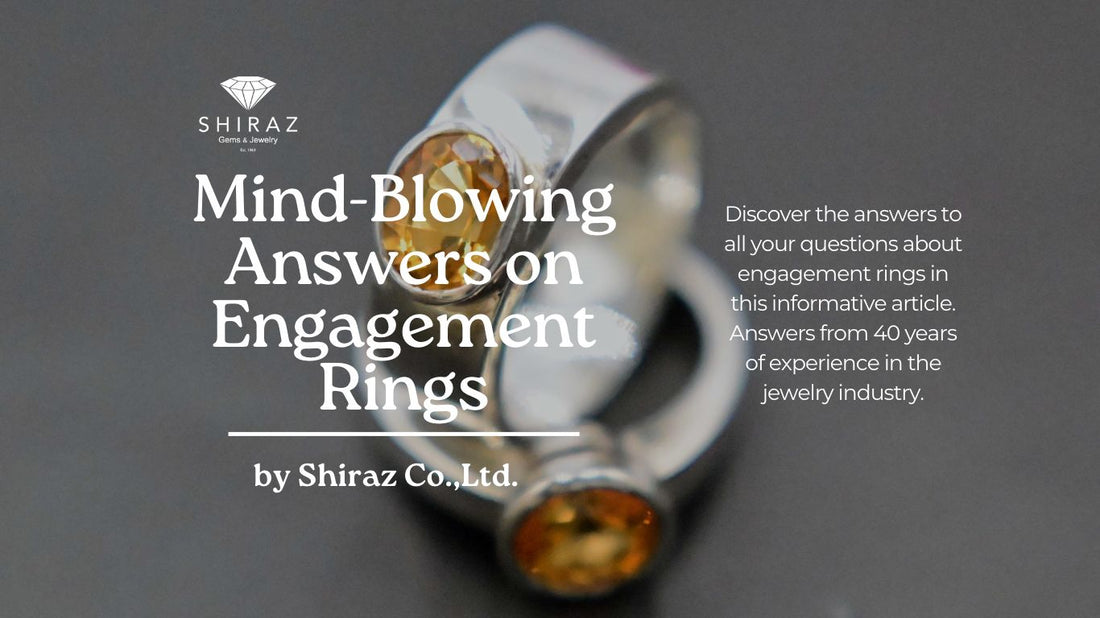
Mind-Blowing Answers: Questions Around Engagement Rings
Shiraz JewelryShare
- As jeweler for 40 years, the answers around engagement ring are summarized here.
- Does your partner prefer a classic and timeless design or something more modern and unique?
- Finger swells due to temperature changes, hormonal fluctuations, or other health conditions can affect ring size, so it's best to get a precise measurement from a reputable jeweler.
I've had a lot of fun as jewelry maker. Some of the things I've figured out, simple questions can make big decisions in jewelry. Here are some simple questions, mind-blowing answers we have for you.
How engagement ring should fit?
An engagement ring should fit comfortably and securely on your partner's finger, while also looking aesthetically pleasing. Here are some guidelines on how an engagement ring should fit:
- Snug, but not too tight: The ring should fit securely on the finger without being too tight. It should go over the knuckle with a little bit of resistance but not feel painful or cause discomfort. It should not leave indentations on the skin or cause redness.
- Ability to twist, but not spin: When the ring is on the finger, it should be able to twist slightly, but it should not spin freely. The ring should have enough room to move, but not be so loose that it constantly spins around the finger.
- Proper alignment: The ring should sit straight on the finger, with the center stone (if the ring has one) facing up and the band sitting parallel to the finger. It should not tilt or twist to one side.
- Comfortable on the sides: The sides of the ring should not dig into the skin or cause discomfort. The ring should feel comfortable when the hand is at rest or in motion.
- Get a professional fitting: It is recommended to have a professional jeweler measure the finger size accurately to ensure a proper fit. Factors such as finger swelling due to temperature changes, hormonal fluctuations, or other health conditions can affect ring size, so it's best to get a precise measurement from a reputable jeweler.
Why engagement ring wear in left hand?
The tradition of wearing an engagement ring on the left hand can be traced back to ancient times and is steeped in cultural and historical significance.
The ring is typically placed on the left hand to symbolize the bond between the couple and their connection to the heart, as it is believed that the heart is located on the left side of the body.
Wearing the engagement ring on the left hand may also have practical reasons. Since the majority of people are right-handed, wearing the ring on the left hand may reduce the risk of damaging or losing the ring during everyday activities.
Which engagement ring to choose?
Choosing the perfect engagement ring is an important decision that requires careful consideration. First, consider the style of the ring. Does your partner prefer a classic and timeless design or something more modern and unique? Additionally, consider their personal style and what type of jewelry they typically wear. This will give you an idea of what type of metal to choose, such as gold or silver, and whether to select a simpler or more intricate design.
Another important factor to consider when choosing an engagement ring is the budget. Engagement rings come in a wide range of prices, and it's important to choose a ring that fits within your budget while still meeting your desired quality and style preferences.
If possible, find out the recipient's ring size beforehand or consider getting the ring resized after the proposal. A well-fitting ring is comfortable to wear and avoids potential issues with the ring being too tight or too loose.
Some people may prioritize ethical considerations when choosing an engagement ring, such as opting for conflict-free diamonds or choosing alternative gemstones, recycled metals, or ethically sourced materials. Research the origins and ethical practices of the jeweler or brand to make an informed decision.
Are engagement ring and wedding ring the same?
Engagement rings and wedding rings are not necessarily the same thing, although they are often used interchangeably or worn together.
Engagement rings are typically given during the proposal or engagement period, as a symbol of a couple's commitment to getting married. Wedding rings, on the other hand, are typically exchanged during the wedding ceremony itself, as a symbol of the couple's marriage vows.
Beside that, engagement rings are typically given before the wedding, during the proposal or early in the engagement period, while wedding rings are typically exchanged during the wedding ceremony itself, often after the vows have been exchanged.
Some people may choose to combine their engagement ring and wedding ring into one ring, while others may prefer to wear them separately. Ultimately, the type of rings chosen and how they are worn is a matter of personal preference and cultural traditions.
Which engagement ring shape looks the biggest?
In short, elongated shapes such as ovals or marquise cuts tend to appear larger than round or square shapes, as they take up more surface area on the finger.
Another factor to consider is the setting of the stone. A higher or more elevated setting can also make the ring look larger, as it offers more visible surface area to the stone.
Ultimately, when selecting an engagement ring shape that looks the biggest, the key is to choose a configuration that is both visually striking and personally meaningful to the wearer. While certain shapes may appear larger or more impressive than others, it is important to prioritize aesthetics and personal style over the simple desire for a “big” ring. After all, an engagement ring should be worn not only as a symbol of love and commitment but as a piece of jewelry that brings joy and beauty to the wearer every day.
